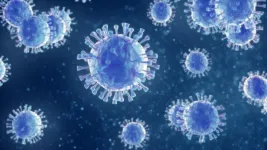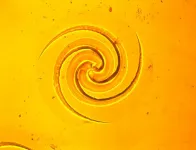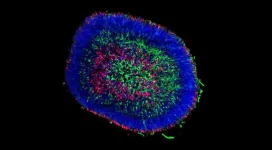(Press-News.org) Researchers from Brazilian, Argentine, and Uruguayan institutions analyze the barriers that low- and middle-income countries face in disseminating research on intensive care medicine, particularly in the treatment of critically ill patients. Published this month in The Lancet, the study highlights how historical and economic biases perpetuate inequalities and suggests changes to make the scientific publishing system more inclusive and representative of the global community.
Low- and middle-income countries are home to 85% of the world's population and bear a disproportionate burden of critical illnesses. However, the global scientific publishing system remains dominated by scholars from high-income countries. This historical imbalance, rooted in colonial-era practices, limits the visibility of crucial research conducted in developing nations. The study, coordinated by the Instituto D’Or de Pesquisa e Ensino (IDOR), the Federal University of Rio de Janeiro (UFRJ), the AC Camargo Hospital, the Heart Institute, and research centers in Argentina and Uruguay, sheds light on these structural disparities.
The academic dominance of high-income countries
Historically, editorial practices and scientific metrics have favored research from high-income nations, relegating studies from low- and middle-income countries to a secondary role.
Key challenges include high article processing charges, often unequal research partnerships, language barriers due to the predominance of English in scientific publishing, and evaluation metrics that prioritize global impact over regional relevance.
These obstacles not only limit the reach of research conducted in developing countries but also reinforce a dependency on recognition and funding from wealthier nations.
The study illustrates how scientific knowledge from low- and middle-income countries proved essential during the covid-19 pandemic. Challenges typically faced by developing nations—such as economic crises and workforce shortages—became realities even for high-income countries.
The global health crisis underscored the value of knowledge generated in countries with resilient and adaptable healthcare systems. However, the lack of representation in high-profile journals continues to hinder recognition of the valuable lessons that the so-called "Third World" has to offer the scientific community.
Proposals for a more inclusive approach to intensive care science
The researchers propose several global and regional actions to foster a more equitable scientific ecosystem. These include increasing the visibility of scientific journals from low- and middle-income countries and reducing or waiving publication fees for authors from these regions in international journals.
Another key recommendation is ensuring a fairer peer-review process, where article evaluations prioritize scientific merit rather than perspectives shaped by high-income countries’ cultural and economic contexts. The authors emphasize that achieving this goal requires greater diversity in editorial boards, which often lack representation from researchers in developing nations.
The study reflects a collaborative international effort to understand and address inequalities in the global scientific publishing system. By challenging entrenched power dynamics and amplifying the perspectives of low- and middle-income countries, the researchers advocate for a more equitable publishing landscape—one that better serves the needs of critically ill patients worldwide.
END
Latin American intensivists denounce economic and cultural inequities in the global scientific publishing system
Study published in The Lancet highlights disparities and obstacles faced by low- and middle-income countries in gaining recognition for their scientific contributions
2025-03-13
ELSE PRESS RELEASES FROM THIS DATE:
Older adults might be more resistant to bird flu infections than children, Penn research finds
2025-03-13
PHILADELPHIA— Prior exposures to specific types of seasonal influenza viruses promote cross-reactive immunity against the H5N1 avian influenza virus, according to new research from the Perelman School of Medicine at the University of Pennsylvania. Older adults who were exposed to seasonal flu viruses that circulated prior to 1968 were found to be more likely to have antibodies that bind to the H5N1 avian flu virus. The findings, published today in Nature Medicine¸ suggest that younger adults and children would benefit more from H5N1 vaccines, even those not tailored specifically to the current strain circulating in birds and ...
Dramatic increase in research funding needed to counter productivity slowdown in farming
2025-03-13
ITHACA, N.Y. – Climate change and flagging investment in research and development has U.S. agriculture facing its first productivity slowdown in decades. A new study estimates the public sector investment needed to reverse course.
In the paper, published in the Proceedings of the National Academy of Sciences, researchers model both the dampening effects of climate change on U.S. agriculture and the accelerating effects of publicly funded research and development (R&D) – and use the estimates to quantify the investment in research required to maintain agricultural productivity through 2050.
They find that a 5% to 8% per year growth in research investment ...
How chemistry and force etch mysterious spiral patterns on solid surfaces
2025-03-13
Key takeaways
Curiosity about a mistake that left tiny dots on a germanium wafer with evaporated metal films led to the discovery of beautiful spiral patterns etched on the surface of the semiconductor by a chemical reaction.
Further experiments showed that the patterns arise from chemical reactions that are coupled to mechanical forces through the deformation of a catalyzing agent.
The new system is the first major advance in experimental methods to study chemical pattern formation since the 1950s. Studying these complex systems will help scientists understand other natural processes, from crack formation in materials to how stress ...
Unraveling the mysteries of polycystic kidney disease
2025-03-13
OKLAHOMA CITY – Polycystic kidney disease (PKD), a family of genetic disorders that causes clusters of cysts to form on the kidney, is among the most common genetic disorders, affecting some 500,000 people in the United States. Roughly one in every 1,000 people will develop some form of cystic kidney disease during their lifetime, and nearly 40,000 Oklahomans have a chronic kidney disease, according to the Oklahoma Health Care Authority.
For many patients, dialysis – a time-consuming and costly procedure – is one of few treatment options. A 2021 study ...
Mother’s high-fat diet can cause liver stress in fetus, study shows
2025-03-13
OKLAHOMA CITY – When mothers eat a diet high in fat and sugars, their unborn babies can develop liver stress that continues into early life. A new study published in the journal Liver International sheds light on changes to the fetus’s bile acid, which affects how liver disease develops and progresses.
Bile acids typically help with digestion and absorb dietary fats in the small intestine, but when they reach excessive levels, they become toxic and can damage the liver. While the mother can detoxify the acids, the fetus lacks that ability. Bile acids may re-circulate to the mother for detoxification, but if they don’t, they build ...
Weighing in on a Mars water debate
2025-03-13
More than 3 billion years ago, Mars intermittently had liquid water on its surface. After the planet lost much of its atmosphere, however, surface water could no longer persist. The fate of Mars’ water—whether it was buried as ice, confined in deep aquifers, incorporated into minerals or dissipated into space—remains an area of ongoing research, one of particular interest to LASP Senior Research Scientist Bruce Jakosky, former principal investigator of the Mars Atmosphere and Volatile EvolutioN (MAVEN) mission.
Last week, in a letter to the editor ...
Researchers ‘seq’ and find a way to make pig retinal cells to advance eye treatments
2025-03-13
MADISON — Inside the human eye, the retina is made up of several types of cells, including the light-sensing photoreceptors that initiate the cascade of events that lead to vision. Damage to the photoreceptors, either through degenerative disease or injury, leads to permanent vision impairment or blindness.
David Gamm, director of UW–Madison’s McPherson Eye Research Institute and professor of ophthalmology and visual sciences, says that stem cell replacement therapy using lab-grown photoreceptors ...
Re-purposed FDA-approved drug could help treat high-grade glioma
2025-03-13
High-grade glioma, an aggressive form of pediatric and adult brain cancer, is challenging to treat given the tumor location, incidence of recurrence and difficulty for drugs to cross the blood-brain barrier.
Researchers from the University of Michigan, Dana Farber Cancer Institute and the Medical University of Vienna established a collaborative team to uncover a potential new avenue to address this disease.
A study, published in Cancer Cell, shows that high-grade glioma tumor cells harboring DNA alterations in the gene PDGFRA responded to the drug avapritinib, which is already approved by the United States Food and Drug Administration to treat gastrointestinal ...
Understanding gamma rays in our universe through StarBurst
2025-03-13
WASHINGTON, D.C. — The U.S. Naval Research Laboratory (NRL), in partnership with NASA’s Marshall Space Flight Center (MSFC), has developed StarBurst, a small satellite (SmallSat) instrument for NASA's StarBurst Multimessenger Pioneer mission, which will detect the emission of short gamma-ray bursts (GRBs), a key electromagnetic (EM) signature that will contribute to the understanding of neutron star (NS) mergers.
NRL transferred the instrument to NASA on March 4 for the next phase, environmental ...
Study highlights noninvasive hearing aid
2025-03-13
WINSTON-SALEM, N.C. – March 13, 2025 – A study from researchers at Wake Forest University School of Medicine highlights a new approach in addressing conductive hearing loss. A team of scientists, led by Mohammad J. Moghimi, Ph.D., assistant professor of biomedical engineering, designed a new type of hearing aid that not only improves hearing but also offers a safe, non-invasive alternative to implantable devices and corrective surgeries.
The study recently published in Communications Engineering, a Nature Portfolio journal.
Conductive ...
LAST 30 PRESS RELEASES:
Decoupling the HOR enhancement on PtRu: Dynamically matching interfacial water to reaction coordinates
Sulfur isn’t poisonous when it synergistically acts with phosphine in olefins hydroformylation
URI researchers uncover molecular mechanisms behind speciation in corals
Chitin based carbon aerogel offers a cleaner way to store thermal energy
Tracing hidden sources of nitrate pollution in rapidly changing rural urban landscapes
Viruses on plastic pollution may quietly accelerate the spread of antibiotic resistance
Three UH Rainbow Babies & Children’s faculty elected to prestigious American Pediatric Society
Tunnel resilience models unveiled to aid post-earthquake recovery
Satellite communication systems: the future of 5G/6G connectivity
Space computing power networks: a new frontier for satellite technologies
Experiments advance potential of protein that makes hydrogen sulfide as a therapeutic target for Alzheimer’s disease
Examining private equity’s role in fertility care
Current Molecular Pharmacology achieves a landmark: real-time CiteScore advances to 7.2
Skeletal muscle epigenetic clocks developed using postmortem tissue from an Asian population
Estimating unemployment rates with social media data
Climate policies can backfire by eroding “green” values, study finds
Too much screen time too soon? A*STAR study links infant screen exposure to brain changes and teen anxiety
Global psychiatry mourns Professor Dan Stein, visionary who transformed mental health science across Africa and beyond
KIST develops eco-friendly palladium recovery technology to safeguard resource security
Statins significantly reduce mortality risk for adults with diabetes, regardless of cardiovascular risk
Brain immune cells may drive more damage in females than males with Alzheimer’s
Evidence-based recommendations empower clinicians to manage epilepsy in pregnancy
Fungus turns bark beetles’ defenses against them
There are new antivirals being tested for herpesviruses. Scientists now know how they work
CDI scientist, colleagues author review of global burden of fungus Candida auris
How does stroke influence speech comprehension?
B cells transiently unlock their plasticity, risking lymphoma development
Advanced AI dodel predicts spoken language outcomes in deaf children after cochlear implants
Multimodal imaging-based cerebral blood flow prediction model development in simulated microgravity
Accelerated streaming subgraph matching framework is faster, more robust, and scalable
[Press-News.org] Latin American intensivists denounce economic and cultural inequities in the global scientific publishing systemStudy published in The Lancet highlights disparities and obstacles faced by low- and middle-income countries in gaining recognition for their scientific contributions





